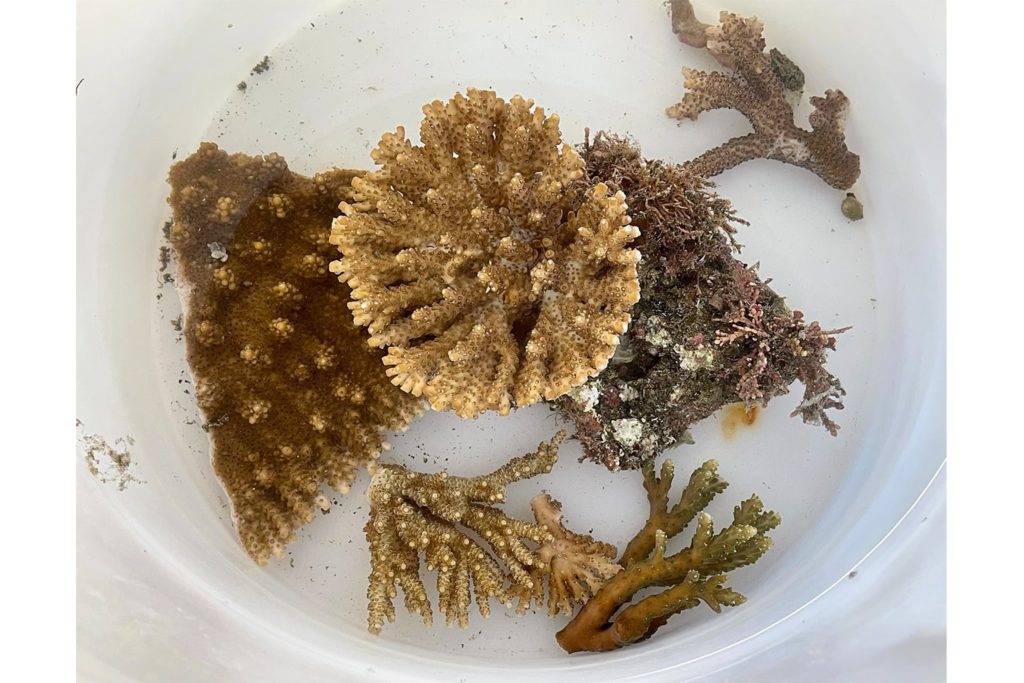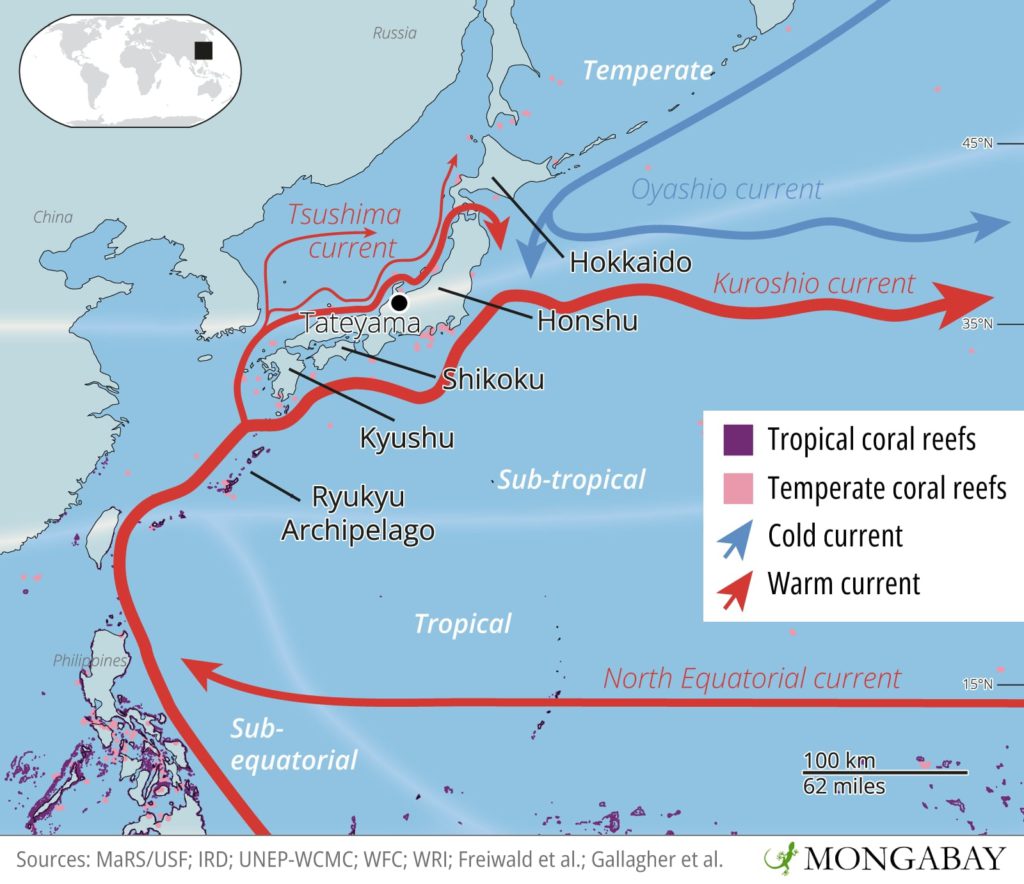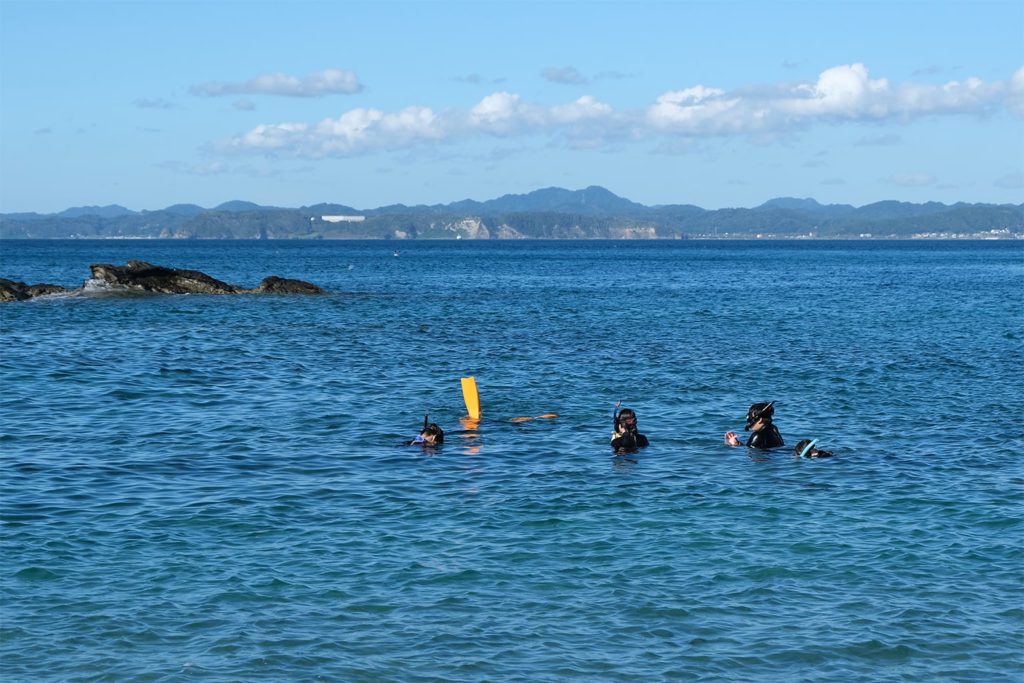- As tropical and subtropical coral reefs succumb to bleaching due to climate change in many parts of the world, the idea that they could take refuge in cooler, temperate seas has offered cause for hope.
- For a while, this is exactly what researchers thought was happening in Japan, where corals are replacing seaweed as the dominant benthos in many places, shaking up both ecosystems and coastal economies.
- But the latest research has tempered those hopes, showing that it’s mainly Japan’s genetically distinct temperate corals that have been expanding their range and edging out seaweed.
- The long-term implications of this shift are unclear, but researchers say it could take tens of thousands of years for these new high-latitude coral communities to evolve the structures, niches and symbioses necessary to support biodiversity on par with the world’s current tropical reefs.
The late summer heat was no concern for University of Tokyo professor Nina Yasuda and her student research team, who descended on Tateyama, an aging resort town on the southeastern tip of Tokyo Bay, armed with snorkels, flippers, GPS devices and tools for DNA analysis one early September day. Their objective was under the waves: Tateyama’s growing coral communities.
Across Japan, from Tateyama in the east to the Ryukyu archipelago in the south, coral researchers like Yasuda are watching with fascination as the country’s coastal seas transform due to climate change.
The threat climate change poses to tropical and subtropical coral reefs—those located within 30 degrees of the equator, which are estimated to support one quarter of all marine life—is well documented and widely understood. Approximately 14% of the world’s reefs have been lost since 2009, largely due to rising sea temperatures that cause corals to expel the symbiotic algae living in their tissue, a phenomenon known as bleaching.
As this biodiversity crisis unfolds, the idea that tropical and subtropical corals could take refuge in cooler, temperate seas has offered cause for hope. That idea seemed to fit into a larger, global phenomenon of “tropicalization,” in which species associated with the tropics are becoming more abundant poleward as temperatures rise, often leading to drastic ecosystem changes. A 2011 study, for example, claimed to show the first large-scale evidence of “the expansion of tropical [coral] species ranges to temperate areas.” In other parts of the world, such as Australia, researchers at the time believed they were seeing a similar phenomenon.
But the latest research from Japan’s coral experts, based on surveys and DNA analysis like Yasuda’s work, has tempered those hopes: Although the country’s coral communities are changing dramatically, poleward “range expansion” of its subtropical corals is occurring only in a small minority of cases.
Instead, Japan’s temperate corals (also referred to as high-latitude corals) are often genetically distinct from their subtropical relatives, even among corals classified as the same species. As climate change brings warmer winters, it’s mainly these temperate corals that have been able to expand their range. In some cases, their expansion is vertical, from deeper to shallower waters that historically were prohibitively cold for corals due to exposure to winter air temperatures. In other cases, the expansion is lateral, with temperate corals taking up more space in their ecosystems or extending their range farther northward. Subtropical corals have appeared in temperate regions as well, although researchers say this is the least common type of range expansion.
In many places along Japan’s coast, including the area around Tateyama, temperate corals are replacing seaweed as the dominant benthos, shaking up both ecosystems and coastal economies. As traditional food sources and marine livelihoods decrease, coastal communities are being forced to quickly adapt to the changing seas.
The rise of temperate corals
Japan—a long, thin archipelago spread between 20–45 degree north latitude, with warm currents running along much of its coast—is an ideal place to study how climate change is causing coral communities to diminish, grow and shift.
As in many parts of the world, Japan’s subtropical coral reefs in the Ryukyu archipelago, the country’s southernmost extent, have experienced bleaching. A 2017 government survey, for example, found that 70% of coral in the Ryukyu archipelago’s Sekisei Lagoon had died from a major bleaching event the previous year. Although bleaching isn’t necessarily fatal if temperatures return to a habitable level, extended periods of high temperatures can be devastating.
In contrast, temperate corals often appear to be thriving in the warming seas along three of Japan’s main islands: Kyushu, Shikoku and Honshu.
“It’s clear that [temperate corals] are increasing across the board” compared with 30 years ago, Takuma Mezaki, director of the Kuroshio Biological Research Foundation, told Mongabay.
Still, Mezaki cautioned that “what’s happening really differs place by place, so it’s hard to lump them all together.” In a given year, one temperate coral community might be ravaged by hungry starfish, another battered by a typhoon, another bleached due to low sea temperatures, even as others expand freely, impacted by none of the above. Understanding overall trends requires decades of observation.
A 2023 paper Mezaki co-authored asserted that, going forward, the “increasing abundances of previously less abundant local coral species may be responsible” for the new dominance of coral in temperate seas. In other words, the corals were there all along, but only recently have they become dominant in their ecosystems.
In fact, corals have a long history in mainland Japan. Tokushima, for example, is home to “millennium coral” estimated to be more than 1,000 years old. And approximately 6,000-year-old coral fossils, encompassing roughly 100 different species, have been found as far north as Chiba (35 degree north latitude), indicating that coral populations have flourished along Japan’s coast during previous warm periods.
Another researcher, University of the Ryukyus professor James Reimer, told Mongabay he observed various changes to coastal ecosystems during a survey of coral communities in the Ryukyu archipelago and temperate Shikoku and Honshu that he completed earlier this year. Mirroring Mezaki, he said what’s happening is not just temperate coral “range expansion, but it is a changing of an ecosystem—or changing of many ecosystems into many other ecosystems.”
In contrast to tropical and subtropical corals, which are keystone species and ecosystem architects that support immense biodiversity in places like the Ryukyus, temperate corals in mainland Japan have until recently played a minor role in seaweed-dominated ecosystems. Although they’re now coming to dominate in some places, Reimer hazarded it would take tens of thousands of years for them to evolve the structures, niches and symbioses necessary to support biodiversity on par with the world’s current tropical reefs. However, he said, temperate corals tend to live a “boom- and- bust” lifestyle—growing rapidly and dying quickly—a characteristic the impacts of climate change could exacerbate and make this evolution unlikely.

No escape hatch
In Japan, corals are able to survive at relatively high latitudes thanks to the warm waters of the Kuroshio Current, which begins in the Philippines and flows past Japan’s Pacific coast before turning into the Pacific Ocean around Chiba. The Tsushima Current, an offshoot of the Kuroshio, serves a similar function along part of Japan’s west coast.
However, the currents don’t necessarily bring coral larvae north along with the warm water. In 2019, researchers analyzed the DNA of a common reef-building coral, Acropora hyacinthus, which lives in both Japan’s subtropical and temperate seas. They found distinct lineages between their temperate and subtropical samples: The southern Acropora hyacinthus corals were not moving north.
“It takes time for the larvae to travel that far north, so if they can’t survive for that long, they won’t make it,” Yasuda, a co-author of the paper, told Mongabay.
Only in the past five years or so has DNA analysis technology advanced enough for researchers to identify genetic distinctions between similar corals. That’s why, until relatively recently, range expansion of tropical corals northward was more widely thought to explain the temperate coral boom, especially when visually similar corals were found in both subtropical and temperate seas.
The presence of distinct lineages means that very few corals, whether tropical, subtropical or temperate, have an “escape hatch” from their changing environments. “We’ve got to protect them where they are,” Reimer said.
The small number of coral species that have made the jump from the Ryukyus to Japan’s mainland include an Okinawan reef coral living at Okinoshima Island off southwest Kochi, according to Mezaki.
As to how these interlopers, still a small minority of the corals present in temperate waters, will fare long-term, Yasuda said, “It’s difficult to draw any conclusions at this stage without careful monitoring to see how these biological communities are changing.”

Finding new value in changing ecosystems
These rapid changes are shaking the foundations of coastal economies on Japan’s temperate main islands, which have long relied on species of seaweed, fish and shellfish that are increasingly scarce as seaweed forests give way to corals. With little long-term financial incentive for marine product businesses, local production and consumption is in danger of further decline: From 2010 to 2020, coastal fishing industry employment in Japan fell from about 125,000 to 74,000, and while nearly all seafood products consumed in the country in the 1960s were produced domestically, barely more than half are today, according to government data.
“Although now we can import food from anywhere, being able to eat from our local environment is also essential,” Mezaki said. “However, many people don’t realize how much that environment is changing.”
Mezaki’s organization, the Kuroshio Biological Research Foundation, serves as secretariat for the Kochi Coral Coastal Ecosystem Adaptation Network, a group of local government bodies, aquariums and research facilities exploring ways to utilize Kochi’s changing marine resources. Mezaki hopes the network, founded in 2022, can expand to nearby prefectures soon.
Many coastal communities around the world will likely face similar challenges and need to adapt flexibly. Like the Kuroshio, other warm, poleward-flowing currents enable corals to grow at relatively high latitudes, and their routes are the first places corals regain dominance during periods of global warming.

For example, Lord Howe Island off eastern Australia (31 degree south latitude) hosts an abundant coral community. However, as in Japan, researchers in Australia have had to revise their understanding of how warming seas are impacting corals: In 2012, researchers claimed to have identified poleward range expansion of corals on the country’s east coast but overturned that conclusion in 2021 after further study found no increase in tropical coral taxa.
In their September visit to Tateyama, Yasuda coached her team on running DNA analysis and marking coral locations with GPS devices while in the water. Going forward, Yasuda said she aims to build a database of Japan’s temperate corals using the data she and her team are collecting in Tateyama and beyond. With more complete information on coral locations, species and lineages, researchers can better understand—and, Yasuda said she hopes, perhaps even predict changes to—the corals in Japan’s dynamic coastal seas.
This article first appeared on Mongabay and was originally written by Annelise Giseburt, a freelance writer based in Tokyo, Japan. It has been republished here under the Attribution-NoDerivatives 4.0 International (CC BY-ND 4.0) Creative Commons license.
